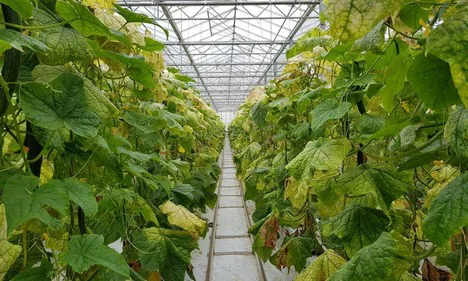An even wider spread of the Cucurbit aphid borne yellows virus (CABYV) in German cucumber cultivation is feared. So far, about thirty infections have been reported in Bavaria last season, but because there is no official reporting obligation, that number could easily be higher, says Patrick Nastvogel of producer organization Gemüseerzeugerring Knoblauchsland e.V. to inFranken.de.
"We had ten samples from the Nürnberg region examined. They were all infected," he says.
In the event of infection with the virus, which has been reported in Germany since the summer of 2019, up to ninety percent of the crop can be affected by chlorophyll deficiency, causing yellowing on the leaves and thickening of the leaves. The fruits also fall faster than intended from the plant and the flowering and growth of new shoots is impeded.

A heavily CABYV-contaminated greenhouse in Bavaria, southern Germany.
In most cases in Bavaria, it involved 10 to 50% of the crop, but the loss of production is nevertheless substantial. The virus is harmless to consumers and, moreover, contaminated product does not end up on the shelf.
Spreading does not take place via direct contact, but through aphids such as the melon aphid (Aphis gossypii), the green peach aphid (Myzus persicae) and the striped potato aphid (Macrosiphum euphorbiae). In winter, aphids can survive on weeds, which means that further outbreaks are feared.
